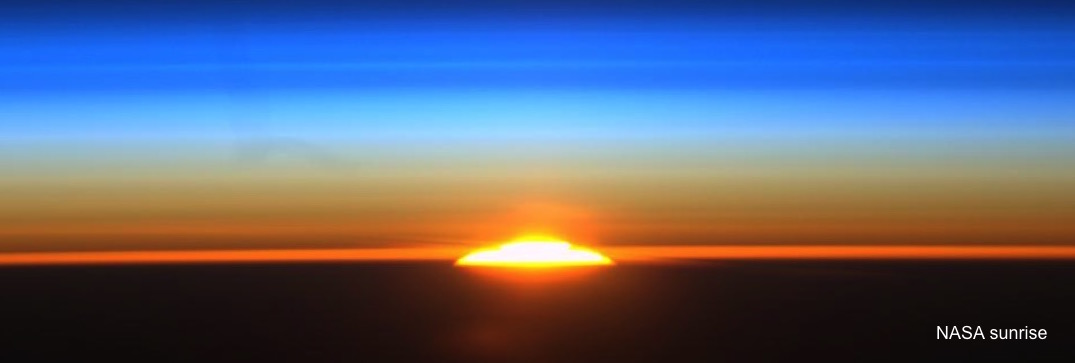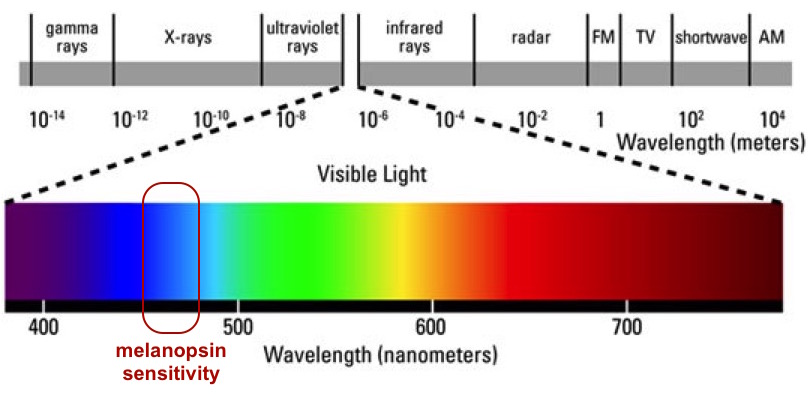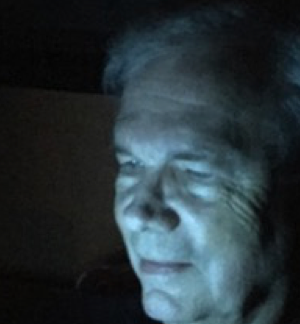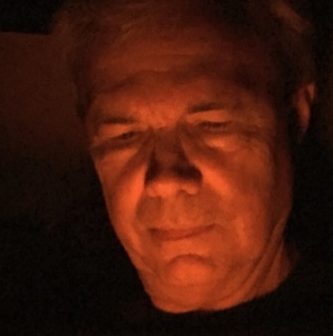Why Blue Light is so Important to Sleep and Health

Why Blue Light is so Important to Sleep and Health
by Leanne Venier, BSME, CP AOBTA
SUBSCRIBE to receive Leanne’s free tips on using Color, Light, Art & Flow State (aka The Zone) for Optimal Health & Healing and Peak Creativity & Productivity.
Blue Light Photoreceptors
Scientific research since 2002 has shown that in addition to the well-known Rods and Cones in our eyes, we also have “Blue light photoreceptors” (ie. melanopsin retinal ganglion cells, a new type of photoreceptor in the eye first discovered in 1998). These “blue light photoreceptors” directly influence our circadian (daily) rhythms.
How Do These Blue Light Photoreceptors Control our Circadian Rhythms? And how can this help my Sleep, Jet Lag or Seasonal Affective Disorder (winter blues)?
These melanopsin blue light photoreceptors are sensitive to a specific range of wavelengths of blue light that, not surprisingly, correspond to the color of BLUE light that we see in a midday sky on a clear day.

Our blue light photoreceptors communicate directly with our pineal gland and control our circadian (daily) rhythms by providing signals to the suprachiasmatic nucleus (SCN), the brain’s master clock. They also project to many other brain regions, influencing myriad aspects of human physiology. And research shows, that these cells are uniquely sensitive to blue light.
Melatonin is a VERY important Hormone and Anti-oxidant

Not only does melatonin help you get sleepy at night, when your melatonin levels are high enough, you are protected from a whole host of diseases, including all types of cancer.
Blue Light and its Connection to Cancer – Research has shown with people who have cancer, that increasing their melatonin levels actually stops and reverses the cancer growth.
Blue light exposure at NIGHTTIME is UNHEALTHY – Avoid Nighttime (ie. after dusk) blue light exposure, because whenever our eyes see light with the blue spectrum, our photoreceptors tell our bodies: “It’s the middle of the day! Be wide awake! Shut off melatonin production!”
All LED Screens Emit A High Percentage Of Blue Light – Blue light is emitted from many light bulbs and from all back-lit LED screens on smartphones, tablets and computers. Notice how blue Wayne’s face looks from the bluish white light emitted from the LED screen of his iPad.
However, Blue light exposure during the daytime is HEALTHY – The BEST source of daytime blue light is from healthy sunshine. Exposure to natural sunlight and daytime blue light helps to regulate the circadian rhythm (body clock) and promote healthy melatonin levels at night. (Also, blue light emitted from your electronic devices during the DAY is not a problem. There’s no need to block blue light from your LED screens during the day.)
Learn More about the Importance of PROPERLY TIMED Blue Light and the many other benefits of Healing Sunshine in Leanne’s TEXAS MD Magazine articles
Blue Light Therapy Devices
If you live up north where there are fewer daylight hours, someplace where it’s often cloudy, work in an office with no windows, or suffer from SAD (Seasonal Affective Disorder), you can benefit from supplementing your daytime blue light requirement with a blue light therapy device in the morning. Such devices also work for treating insomnia and DSPS (Delayed Sleep Phase Syndrome).
Scientists have shown that by being exposed to specific wavelengths of blue light during daytime hours suppresses melatonin production (as it should, since we evolved to stay awake during the day), and then our bodies are more ready to produce melatonin at night. Blue light exposure during the morning and midday hours actually helps increase nighttime melatonin production, and that’s a VERY good and HEALTHY thing. This is the basic premise behind Blue Light Therapy devices that help retrain the biological clock and our circadian rhythms.
There are other blue light therapy devices for SAD and DSPS, but after reading countless reviews and trying many for myself, I can now personally recommend this Philips Blue Light Therapy Device. It’s well-constructed, compact, sturdy and doesn’t buzz like some less expensive models reportedly do. It’s the model I’ve been using for years and it continues to work great.
Leanne’s Personal Story using her Blue Light Therapy Device
For over 15 years I suffered from delayed sleep phase syndrome (DSPS) and was unable to fall asleep before 2 am. In recent years, my bedtime had gotten pushed even later to as late as 4 am. I would consistently wake up between 8 and 10 am each morning, but never felt fully rested, and I wouldn’t feel fully awake until 1 or 2 in the afternoon. Although I tried many times to go to bed earlier and get up earlier, I failed every time to shift my sleep schedule.
I thought I was just a night owl and had resigned myself to this late night schedule. Until, that is, I was doing research for my talks about the Healing Effects of Color, Light and Art, and I read about DSPS. This is a condition where a person’s biological clock (circadian rhythm) gets so off-kilter, where their body is no longer able to follow regular, healthy biorhythms. People with this condition produce less melatonin than is healthy and as such, they don’t get sleepy when they should – when it gets dark outside.
Since I’ve worked for myself for over 15 years, my night owl lifestyle wasn’t that big a deal because I could start work late in the day and work late into the evening. But I was definitely beginning to feel the negative effects of not being on a proper sleep schedule.
As soon as I learned about DSPS and how blue light therapy was discovered to be an effective treatment, I researched several Blue Light therapy devices and ended up buying my Philips Blue Light Device. In just 3 days, I shifted my circadian rhythm and internal clock by a full 3 hours!
I now go to bed between midnight and 1 am (by choice since this suits my lifestyle), and I get up between 7 and 8 am feeling fully rested without the several hours lag before my body and brain wakes up. I start getting sleepy once it starts getting dark, and by midnight I’m ready for my head to hit the pillow. I feel like a new person! And my early morning friends are still in awe!
Note that I sometimes slip into my late night owl habits, but it’s nothing like it used to be. Whenever I start pushing past my sleepy time at night and start going to bed too late, I just use my blue light therapy device for a few days (15-30 minutes in the morning as soon as I get up), and I get back on track again. I soon start getting sleepier earlier and start going to bed earlier and getting up earlier.
I’ve recommended the same Blue light therapy device to many people who’ve been suffering from insomnia or poor sleep, and they’ve all reported that within 2 or 3 days they too were sleeping better at night and feeling more wide awake and productive during the day!
Avoid LED Screens at Night since their blue light suppresses melatonin
LED screens from our smartphones, iPads or other tablets, and our computers all emit a large amount of stimulating blue light. (You may perceive the light coming from your computer screen as white, but that white has a high amount of blue.
To understand how White light varies based on its constituent colors, just think of warm incandescent bulbs that contain more warming reds, oranges and yellows. Then compare that to a cool blue fluorescent bulb which has a lot more blue within its white light. They may both look white, but they’re made up of different colored wavelengths that influence the warm or cool nature of their white light.
See What is Color and Light for an in-depth explanation of how white light is created and how not all White light is created equally so you can better understand how LED screens emit a lot of blue light.
LED screens are similar in that they emit white light, but it’s a very BLUE-based white light. It’s best to stop using all LED screen devices at least an hour before bedtime.
(Reading printed books or non-back-lit e-books like the original black & white Kindle is fine.) It’s also best any time after dusk to cut all blue light from your field of vision in order to encourage proper melatonin levels.
Free Apps to Eliminate Blue Light from LED Screens

An effective way to cut the blue light from our computers at night is to install a free and safe program called F.lux on all of your computers. Beginning at dusk, this program slowly starts to change the screen colors to be a more soothing, soft peachy pink instead of that glaring blue-white light that suppresses melatonin and causes insomnia.
Visit https://justgetflux.com/ to install the program. The download and installation only takes a few seconds to complete. I recommend you do this at night so you can see the instant and dramatic shift in the colors emitted from your computer screen as soon as the program kicks in. You’ll be amazed at the difference and how much more calming and soothing the resulting warm screen looks compared to the stark blue screen.
https://justgetflux.com/
Related Articles
- Why Color and Light Matter is another article by Leanne Venier that offers Secrets for Improving your Sleep, Health & Productivity
- What’s in a Color? The Unique Human Health Effects of Blue Light is an excellent medical research paper that’s all about the benefits of properly timed blue light and the hazards of improperly timed blue light. It’s written in layman’s terms and is very easy to understand
- Are we sleep-deprived or just darkness-deprived?, by Professor Richard G ‘Bugs’ Stevens, University of Connecticut School of Medicine, argues that the type of light we use at night matters.
- How Light from Electronics Affects Sleep, by Wayne Caswell, notes that screen size and distance also plays a role.
-
MELATONIN: Breakthrough Discoveries That Can Help You Combat Aging, Boost Your Immune System, Reduce Your Risk of Cancer and Heart Disease, Get a Better Night’s Sleep, Book by Russel J. Reiter, Ph.D., and Jo Robinson
About the Author
 Leanne Venier, BSME, CP AOBTA, is an international award-winning artist, engineer and expert in the science of color & light who regularly lectures at major medical centers, SXSW Interactive, MENSA & elsewhere, combining her art with her past careers as a mechanical engineer then acupuncturist to teach medical doctors, executives and lay people about the latest scientific research for optimizing health & productivity using color, light, Art & Flow State.
Leanne Venier, BSME, CP AOBTA, is an international award-winning artist, engineer and expert in the science of color & light who regularly lectures at major medical centers, SXSW Interactive, MENSA & elsewhere, combining her art with her past careers as a mechanical engineer then acupuncturist to teach medical doctors, executives and lay people about the latest scientific research for optimizing health & productivity using color, light, Art & Flow State.
She has been interviewed on NBC-TV, nationally syndicated radio, international podcasts and in numerous magazines about color, light, optimal health and Flow state, and is a regular contributor to Texas MD Magazine. Leanne also conducts Color & Creative Flow Training where business executives, entrepreneurs and lay people learn to quickly and reliably get into Flow State, an optimal state of consciousness where Insights, Innovation, Peak Productivity & Optimal Health occurs.
Leanne’s international award-winning artwork can be viewed on her healing artwork site leannevenier.com. Leanne is available for Color & Creative Flow Workshops & Training sessions, Flow Coaching Consultations, Healing Color & Light Consultations and Speaking Engagements,

Blue light makes us hyper – can red light calm us down?
The blue part of the light spectrum is very strong in smart phones, tablets, television and other electronic devices with light-emitting screens. Blue light affects the biological clock and sleep-regulating neurons in the brain. Evening exposure, therefore, can make it difficult to settle down in the evening for a restful night of sound sleep.
Research has focused so strongly on blue light, that other colors of the spectrum have been neglected somewhat. Van der Meijden and colleagues from the Netherlands Institute for Neuroscience in Amsterdam have now for the first time systematically evaluated what happens after exposing ourselves to many minutes of intense red light only. Prior red light had some unexpected effects that were mostly opposite to the effects of blue light. After red light, it took participants more effort to perform a task requiring attention. Their reaction times also slowed. Most surprising, prior exposure to intense red light also made it easier to fall asleep. The findings, published today in Proceedings of the Royal Society B: Biological Sciences, suggest that red light might counteract some of the adverse effects of blue-light emitting screens. Red light may even turn out to be useful as night cap.
Jean,
Reading a book with a low-wattage incandescent lightbulb is generally better than any of the energy-saving bulbs (fluorescent or LED), but you can now buy LED bulbs with a “warm” color temperature, meaning they have less blue. Better still is to avoid blue altogether. Since I published this article, Apple updated its iPhone & iPad software to do what f.lux does — turn down display brightness and remove blue light. Use Settings/Brightness to adjust to your preference.
Your question also mentions nightlights, but it’s very hard to find a non-blue nightlight that does not inhibit melatonin. Below are two ways I’ve modified available lights. The first example replaced the clear incandescent bulb with an orange one. In the second example, I glued a circle of orange construction paper over an LED light that puts out no heat. Both nightlights include photosensors so they come on automatically when it’s dark.
Is it advisable to find a non-blue light reading/night light for insomnia reading in the middle of the night? I can’t seem to find a source so perhaps it’s not necessary. Will a .5 watt night light inhibit melatonin?